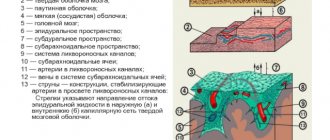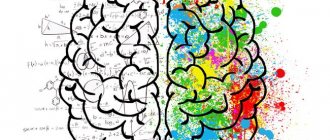There are several forms of disorientation: psychological, which usually manifests itself as a syndrome of derealization and depersonalization, and neurological, which occurs with more obvious symptoms. The latter occurs against the background of organic brain damage. Disorientation requires mandatory comprehensive treatment, but the medical doctor determines the treatment regimen only based on the results of a diagnostic examination.
Main reasons
Currently, in psychology the term “personal disorientation” is practically not used; it is believed that the names “depersonalization” and “derealization” more reflect the clinical picture of this syndrome. This phenomenon occurs in the following mental disorders:
- schizophrenia;
- depression;
- manic syndrome and bipolar affective disorder;
- phobic neuroses, agoraphobia and social phobia, against which panic attacks occur;
- post-traumatic stress disorder;
- psychopathy;
- severe course of delusional syndrome with hallucinosis.
“True” disorientation, which is accompanied by a violation of orientation in time and space, usually occurs in severe neurological diseases with the localization of the pathological focus in the areas of the brain “responsible” for orientation in space and in a certain area. These are the hippocampus and other parts of the temporal lobe, the prefrontal and parietal cortex.
The main reasons for such a violation are:
- acute and chronic cerebrovascular accidents due to stroke, atherosclerosis;
- consequences of traumatic brain injuries;
- dementia, Alzheimer's disease;
- encephalopathy of various origins (hepatic, toxic, etc.).
Brain disorientation is also possible with cognitive deficits in older people associated with age-related changes in the systemic circulation and the functioning of the central nervous system.
Another equally common cause of disorientation is alcohol and drug intoxication. Some medications that depress or, conversely, stimulate the activity of the central nervous system, have a similar effect. This:
- sedatives and hypnotics;
- neuroleptics;
- antidepressants;
- some potent analgesics;
- anticonvulsants;
- means used to put the patient into medicated sleep;
- powerful broad-spectrum antibiotics, etc.
The risk of impaired consciousness is especially high if the patient does not follow the doctor’s recommendations and independently increases the prescribed dosage.
Causes of disorientation in space
The described disorder is a change in consciousness that does not allow the individual to think clearly and quickly, in addition, it causes a loss of the ability to recognize people or distinguish places, remember time and memorable dates. Disorientation often leads to clouding of consciousness and the inability to make independent decisions.
There are many reasons that provoke the deviation in question. For example, it can be caused by organic damage to brain structures or metabolic disruptions. In older people, loss of orientation and mental fog are often caused by senile dementia.
In addition, there are diseases accompanied by disorientation.
Incoherence of consciousness can occur due to hypoxemia, observed with pulmonary diseases, with serious infectious processes, malnutrition, due to dehydration.
Incoherence of consciousness also manifests itself due to the influence of a number of external circumstances, such as hypothermia or heat stroke.
Diseases accompanied by disorientation can be identified as Alzheimer's disease, hydrocephalus, spastic pseudosclerosis, tumor formation in the brain and a disorder of its blood supply, dementia, autism, hypoglycemia, depressive states, fatty hepatosis, psychotic disorder of the body, Angelman syndrome, portal hypertension, renal failure , anxiety disorders, schizophrenia, meningitis.
In addition to the listed ailments, excessive consumption of alcohol, drugs, and dehydration can cause a feeling of personal disorientation.
Social disorientation can occur as a result of a sudden change in life. In children, loss of social orientation is the norm, since the little ones are not yet able to recognize their occupation or their own gender. It is difficult for them to navigate among new faces.
Only at the puberty stage does the time of absolute social orientation come.
Clinical signs and classification of the syndrome
The ability to navigate both in one’s own personality and in the area is a complex process that affects almost all areas of cognitive activity. A person perceives certain information (usually visual or sound images), recognizes it, evaluates the location of “beacons” - objects that are used to “link” to the area, plans and subsequently remembers his route.
And depending on at what stage this process is disrupted, several types of disorders are distinguished:
- emotional;
- egocentric;
- allocentric;
- memory.
Emotional disorientation
Starting from early childhood, a person becomes oriented towards his own personality. He understands who he is, plans his future actions, sets certain goals for himself as he grows up and makes efforts to achieve them. The following symptoms are characteristic of psychological disorientation:
- lack of motivation for any activity;
- rapid distractibility, inability to concentrate on the work at hand for a long time;
- mood swings: dysphoria can abruptly give way to hypomania or manic syndrome with general emotional and psychomotor agitation, an insatiable thirst for activity;
- the feeling that you see yourself and what is happening around you from the outside;
- delusional ideas: the patient sincerely considers himself either an inventor or a reformer, is confident in his exclusivity and uniqueness, sometimes delusions of persecution, relationships, or falling in love develop;
- inability to follow generally accepted norms and rules of behavior.
This condition occurs occasionally, during an exacerbation, or persists constantly. In severe mental disorders (for example, schizophrenia or psychopathy), stable remission can only be achieved with constant use of antipsychotics.
Disorientation of memory
It occurs quickly, which is typical for acute cerebral circulatory disorders, head injuries, or develops gradually, for example, in Alzheimer's disease or vascular dementia. In the first case, the amnestic period usually covers the events preceding the exacerbation; sometimes the patient cannot remember anything at all from his past life.
In dementia or encephalopathy, memory disorientation develops gradually. At first, a person forgets events that happened long ago; as the disease progresses, he stops recognizing his loved ones, cannot remember even basic things, and loses self-care skills.
Egocentric disorientation
With this type of syndrome, the ability to spatial orientation is lost. A person can name all the surrounding objects, the memory is preserved, but he is not able to say whether an object is on the right or left, above or below, far or close.
Allocentric disorientation
The patient is unable to correlate his position with certain landmarks on the ground. Because of this, he cannot even take the usual route, but quite clearly and accurately answers questions regarding his personality, residential address, names of relatives, etc.
Symptoms of spatial disorientation
The following types of personal disorientation are distinguished: radiation, spatial, professional and social disorientation.
Psychology offers the following classification of orientation disorders:
– autopsychic (which is a false recognition of oneself as a person or an absolute loss of self-identification);
– allopsychic (loss of orientation in the environment);
– double (the patient simultaneously or alternately resides in reality and imaginary reality);
– mixed or total disorientation.
A doctor can determine the state of disorientation only after conducting an examination.
Common clinical signs include symptoms such as sudden mood changes, dizziness, dream disturbance, and memory impairment.
Disorientation in space is often observed along with an inability to determine time. In addition, the disease in question may be accompanied by such manifestations as the subject’s inability to recognize himself as an individual, name the month, current year, country of residence or place of residence, and passport details.
A feeling of fear and anxiety also arises without an obvious reason. Apathy can suddenly give way to an attack of aggression. Therefore, it should be taken into account that the described state of the subject is often unsafe both for the person suffering from disorientation and for those around him. That is why, if the listed signs occur, a person should be immediately transported to a medical facility.
Social disorientation, as a rule, is not characterized by the presence of pronounced manifestations of a mental disorder. However, the following specific symptoms may occur. So, for example, the subject cannot tell his exact age. He also does not know his own social identity. In an unfamiliar environment, a feeling of uneasiness arises.
In the presence of VSD, spatiotemporal disorientation may be accompanied by: dizziness, ringing in the ears, nausea, partial hearing loss, headaches, and fluctuations in blood pressure. This condition poses a threat to the life of the individual. Self-medication or ignoring the described symptoms can lead to serious consequences and can also be fatal, since pressure surges can cause a stroke or provoke a heart attack.
Disorientation in space is a frequent accompaniment of twilight clouding of consciousness. Characterized by a sudden appearance and an equally sudden disappearance. The subject retains the ability to reproduce mechanical actions.
Cost of services
| CONSULTATIONS OF SPECIALISTS | |
| Initial consultation with a psychiatrist (60 min.) | 6,000 rub. |
| Repeated consultation | 5,000 rub. |
| Consultation with a psychiatrist-narcologist (60 min.) | 5,000 rub. |
| Consultation with a psychologist | 3,500 rub. |
| Consultation with Gromova E.V. (50 minutes) | 12,000 rub. |
| PSYCHOTHERAPY | |
| Psychotherapy (session) | 7,000 rub. |
| Psychotherapy (5 sessions) | 30,000 rub. |
| Psychotherapy (10 sessions) | 60,000 rub. |
| Group psychotherapy (3-7 people) | 3,500 rub. |
| Psychotherapy session with E.V. Gromova (50 minutes) | 12,000 rub. |
This list does not contain all prices for services provided by our clinic. The full price list can be found on the “Prices” , or by calling: 8(969)060-93-93. Initial consultation is FREE!










